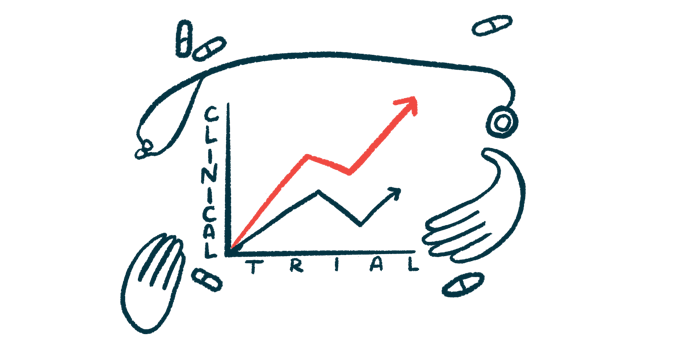Pozelimab-cemdisiran treatment shows promise for PNH in trial
Combo appears to work better than Ultomiris for hemolysis control: Data

A novel combination of pozelimab and cemdisiran appears to be better than Ultomiris (ravulizumab) at controlling intravascular hemolysis — the rupture of red blood cells inside blood vessels — in adults with paroxysmal nocturnal hemoglobinuria (PNH), showing promise as a potential treatment for the rare acquired disease.
That’s according to exploratory data from the ongoing, open-label Phase 3 ACCESS-1 clinical trial (NCT05133531) and its follow-on extension, ACCESS-EXT (NCT05744921), which are testing the safety and efficacy of the experimental combination treatment in PNH patients who are new to, or have not recently received, complement inhibitors.
In these studies, subcutaneous or under-the-skin injections of pozelimab plus cemdisiran are given at four-week intervals to people with PNH. The data thus far show that such treatment resulted in lower levels of lactate dehydrogenase — known as LDH, it’s a marker of hemolysis — compared with Ultomiris, an approved complement inhibitor being infused into the vein, or intravenously, every eight weeks as a maintenance therapy.
The pozelimab-cemdisiran combination is also being tested in a separate registrational arm against Soliris (eculizumab), another complement inhibitor approved to treat PNH. Patients in both arms may enter ACCESS-EXT, which is evaluating the long-term safety and efficacy of the combination therapy, including in patients who switch from Ultomiris or Soliris.
The clinical trials are being sponsored by Regeneron Pharmaceuticals, which is developing pozelimab for PNH and other complement-mediated diseases. Its use in combination is being tested under an agreement with Alnylam Pharmaceuticals, which developed cemdisiran.
“These data validate this novel combination approach, and we look forward to results from the registrational [arm], which if repeated, could help transform what may be possible for many people with PNH,” Christopher Patriquin, MD, a trial investigator from the University of Toronto in Canada, said in a Regeneron press release.
Patriquin, who also serves as a hematologist at the University Health Network in Toronto, said “the complementary mechanisms of pozelimab and cemdisiran enabled complete, rapid, uninterrupted and durable inhibition of … complement throughout the dosing interval.”
The findings were presented in an oral session at the 2024 American Society of Hematology (ASH) annual meeting, held last month in California and virtually. The abstract was titled “Efficacy and Safety of Pozelimab Plus Cemdisiran Vs Ravulizumab in Patients with Paroxysmal Nocturnal Hemoglobinuria Who Are Naïve to Complement Inhibition.”
Not all patients respond well to Ultomiris, other C5 inhibitors
In PNH, red blood cells become liable to hemolysis upon attack by an overactive complement system — a group of proteins that normally work as part of the immune system to protect the body against infection. Hemolysis can occur inside or outside blood vessels, leading to a range of symptoms.
Complement inhibitors like Ultomiris and Soliris can help control hemolysis by blocking the action of C5, a protein of the complement system. However, not all patients respond well to these medications, and many keep experiencing symptoms, requiring blood transfusions within the first months of treatment.
“C5 inhibitors are widely considered the mainstay of PNH treatment, but a proportion of patients still do not achieve adequate control of intravascular hemolysis, may experience residual anemia [too few red blood cells], and may feel significant treatment burden, as many of these therapies require clinic or home visits for intravenous delivery,” Patriquin said.
According to the researchers, “the combination of pozelimab and cemdisiran … is a novel approach currently being investigated for its ability to achieve complete, durable inhibition of … complement.” In addition to PNH, the combo may work for other complement-mediated diseases, the team noted.
Used together, pozelimab and cemdisiran combine two complementary mechanisms to target C5 and halt complement activation. Pozelimab is an antibody that blocks the action of C5, while cemdisiran is a small interfering RNA molecule that reduces C5 production in the liver.
Combo treatment helped more PNH patients achieve target LDH levels
In the exploratory arm of ACCESS-1, 48 patients were randomly assigned to receive either the combination of pozelimab and cemdisiran, or Ultomiris, over 26 weeks, or slightly longer than six months. More patients on the combination treatment achieved adequate hemolysis control, defined as an LDH level no greater than 1.5 times the upper limit of normal (96% vs. 80%).
“The combination helped more patients achieve target LDH levels compared to the current standard-of-care C5 inhibitor, with the added benefit of infrequent four-week subcutaneous delivery that has potential for self-administration,” Patriquin said.
At the end of the 26 weeks of treatment, five patients on Ultomiris failed to achieve meaningful LDH control, while one patient on pozelimab plus cemdisiran did. Four of those five Ultomiris-treated patients achieved hemolysis control after switching to the combination therapy.
The [pozelimab-cemdisiran] combination helped more patients achieve target LDH levels compared to the current standard-of-care C5 inhibitor [Ultomiris], with the added benefit of infrequent four-week subcutaneous delivery that has potential for self-administration.
Over weeks 8-26, those on Ultomiris responded close to what would be expected based on historical data, while most patients on pozelimab plus cemdisiran achieved LDH normalization across visits (93% vs. 65%). Normalization was defined as a LDH level no greater than the upper limit of normal.
In ACCESS-EXT, patients who completed ACCESS-1 switched to the combination. Among the 19 patients who had previously received Ultomiris, about two-thirds (68%) had achieved LDH control at the start of the open-label extension. After switching, 95% of these patients achieved LDH control.
The safety profile of pozelimab plus cemdisiran was consistent with that of approved C5 inhibitors, with treatment-emergent side effects occurring about as frequently in both groups (84% vs. 87%). In ACCESS-EXT, side effects were mild to moderate, with no hypersensitivity (allergic) reactions or treatment discontinuations.
“The combination of pozelimab and cemdisiran led to robust control of LDH,” the researchers concluded in the presentation abstract. These “results support development of the combination of pozelimab and cemdisiran in PNH and other complement-mediated diseases,” they added.









